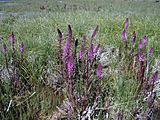Pedicularis groenlandica facts for kids
Quick facts for kids Pedicularis groenlandica |
|
|---|---|
 |
|
| Henry M. Jackson Wilderness | |
| Scientific classification |
Pedicularis groenlandica is a beautiful flowering plant. It is often called elephant's head or elephanthead lousewort because of its unique flower shape. This plant belongs to the Orobanchaceae family.
Contents
What the Elephant's Head Plant Looks Like
This plant stands tall and straight. It can grow up to about 80 centimeters (31 inches) high. Its leaves look a bit like ferns and have sharp teeth along their edges. These leaves grow low down on the plant's strong stem.
At the very top of the stem, you'll find a large cluster of bright flowers. These flowers can be pink, purple, or even white. Each flower has a long, pointed part that curves upwards. This part looks a lot like an elephant's trunk! The sides of the flower also stick out, making them look like an elephant's ears.
How the Elephant's Head Plant Gets Food
The elephant's head plant is special because it's a root parasite. This means it gets some of its food and nutrients from other plants! It does this by attaching itself to the roots of nearby plants. It uses special parts called haustoria to gently pierce the roots of other plants. This way, it can take in the water and nutrients it needs to grow and thrive.
Where the Elephant's Head Plant Lives
You can find the elephant's head plant in the tall mountain ranges of western North America. It grows in places like the Cascades and the High Sierra. It also lives in many parts of Canada and even Greenland. This plant loves wet places, so it often grows near riverbanks and in damp environments.
- Pedicularis groenlandica
-
Colony along Firehole River, Yellowstone National Park
See also
 In Spanish: Pedicularis groenlandica para niños
In Spanish: Pedicularis groenlandica para niños



